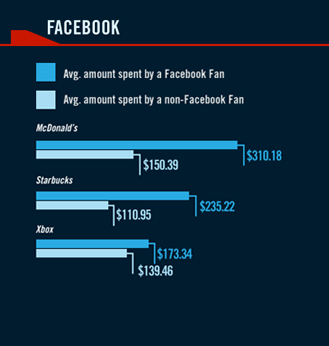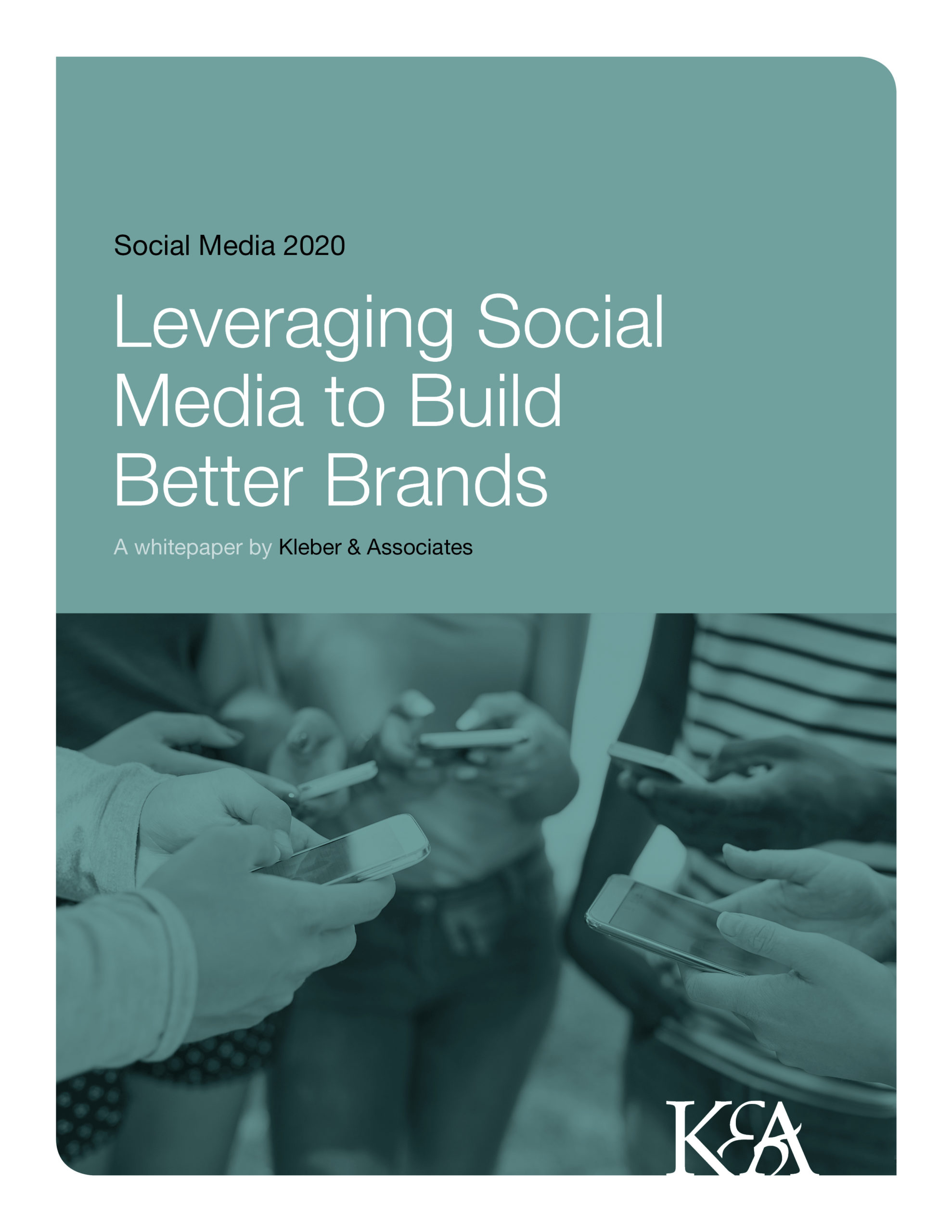Social Media 2020 Leveraging Social Media to Build Better Brands
A white paper by Kleber & Associates
In the wake of uncertain markets, global pandemics and social distancing, social media and its various interactive marketing platforms are more important than ever. In fact, brand managers across the country are looking for better ways to help them develop new abilities to scale across multiple social networks and determine the most effective strategies for engaging fans and driving leads. They want to know how to determine return-on-investment for their important stakeholders, as well as, the ideal mix to target search activity while leveraging content relevancy.
Now, more than ever, your blog, Facebook page and Twitter accounts are all now among the most vital members of your marketing team. And as such, they deserve more than mere recognition. Rather, they need nurturing and evaluation platforms that will rival even the most well-equipped human resources department. So, how should you best leverage the next phase of activity in your brand’s social media presence? This white paper highlights the 10 most important questions you must be able to answer regarding your social media evaluation process. If your business isn’t active on social media or you haven’t evaluated your social media outreach in a while, this advice will serve as convenient baseline for further consideration. In these changing times, it’s more important than ever for building product companies to be able to offer value, even from a distance.

1: How can I gather business intelligence through social media?
“Build it and they will come” only works in the movies. Social Media is a “build it, nurture it, engage them, and they may come and stay.” – Seth Godin, author of “Permission Marketing” and “Tribes”
Social networking should not be underestimated as a powerful business tool. Simply put, if you are not maximizing social networking to your brand’s advantage, then you are not “firing on all cylinders.” One of the best ways to leverage social media for your brand is to monitor the web for sentiment surrounding you and your competitors. Oftentimes, brands are too concerned with the message they want to spread and fail to cater their overall mission to their audience simply because they are not listening well enough.
The integration of social media has become the most valuable tool for sending relevant information quickly into the hands of customer service, management and sales representatives.
Ask yourself:
- Who is engaging with my brand?
- How influential are they?
- Are there common messaging points?
Assessing your brand, however, is just the tip of the iceberg. Brands can gain a great deal of competitive advantage and intelligence by following their competitors on social media.
Have your competitors identified audiences that you have yet to reach?
- Where are they finding the greatest success?
- Where are your competitors weak on social media, and how can you leverage this to your brand’s advantage?
Social media provides valuable information to which brands would not have access otherwise. Brands must be listening and be prepared to take advantage of opportunities.
Uncovering the secrets of corporate rivals
Businesses across all industries are now collecting real-time intelligence and data to develop a competitive advantage.
- Follow a rival company on Google Alerts, LinkedIn and other business platforms and you’ll get alerts on their hires, who they are connecting with and which companies they follow.
- Monitoring a competitor’s Twitter and Facebook page may give you insight into customer complaints, or how your rivals are promoting to their audience(s).
- Business Groups on LinkedIn are another area to gather information on a competitor’s experience and authority. It is also a place to participate and enhance your leadership in the field. The best groups often are created by leading brands in the marketplace.
2: Why isn’t my business’ social media following growing faster?
“Quit counting fans, followers and blog subscribers like bottle caps. Think, instead, about what you’re hoping to achieve with and through the community that actually cares about what you’re doing.” – Amber Naslund, VP Social Strategy, Radian6
There are many reasons why a company’s social media strategy may be stagnant. Perhaps there isn’t a strategy to begin with! Or, a strategy may be in place that is missing the mark or is not correctly identifying your target market. Determining the proper strategy and connecting with the correct target markets are the first steps to a successful social media presence. The next is making sure you or your current agency are not making any of the following common mistakes:
- Not promoting your social profiles enough. Just because you have a Facebook and Twitter account does not mean they will grow themselves. It is important to get the word out regularly. While dedicated fans may find you organically… others may need a little push. So, utilize your website, collateral materials and e-blasts to leverage their full potential.
- Updating social media pages too often or too little. After designing the right strategy, it is important to establish guidelines for posting to social media sites. Posting too often can make followers feel bombarded… and posting infrequently may leave them bored with your brand. The best way to judge posting frequency is by feedback from fans and followers and participating accordingly.
- Not offering value to your followers. Why should someone “like” or “follow” you? What are you giving them? Providing appropriate content is only part of the puzzle. Fans are looking for a VIP experience that they can’t get from a website. Launching promotions and contests are great ways to increase your social media following and can be effective techniques to increase engagement.
Quick ways to increase a Facebook fan base
Many believe if you build a Facebook page… the fans will come. However, fans do not magically appear from the Facebook mist. A few extra tactics to better your chances of growing a fan base:
- Make the social media icons on your website easy to find. Many companies bury social media and other contact information deep in their site. Putting your contact info front and center lets customers know you aren’t afraid to have a conversation.
- Add a link to your email signature. It is not recommended to add the actual social media icons to email signatures, however placing the words “Facebook,” “Twitter,” etc. and linking them to your social media sites will encourage people to click and join.
- Place Facebook ads. Even with a small weekly/monthly budget, you should be able to boost fan count using Facebook’s own social media ad feature. It’s among the most targeted traffic money can buy.

3: Are my social media pages optimized for search?
“In the end, the winner is content. Good content, sharable content, and consumer-driven content will allow us all to have a broader spectrum of information and, for the marketer, an easier way to connect with their base.” – Aaron Kahlow, founder, Society for Social Health and Well-Being
With SEO (search engine optimization) the goals are clearly defined: to make a website visible to the search engines. Social media remains one of the most important ways to achieve this. One way to determine if social media pages are achieving goals is to look at website traffic. If website traffic is not growing, then perhaps you should reevaluate your SEO strategy. Here are a few ways to boost social media page optimization:
- Identify your brand’s relevant keywords. What key words or phrases drive traffic to your website already? What is your website’s reason for being? Once these keywords are established – just like building a website – they should be used throughout social media profile descriptions. Next, it is extremely important to use these keywords when updating your page with content relevant to your industry.
- Make sure your social profile URLs are named after your business. Save the memorable, clever URLs for special promotions, microsites and landing pages.
- Make content easily linkable. Remember to add links to all of your other social media pages to increase inbound links. These inbound links help search engines understand the popularity of your website, blog or social profile. The more inbound links you have, the higher the page will rank in search results.
- Post interesting content. The better your content, the more likely people are to share it with others… establishing greater search engine authority.
Discovering keywords
The first step in any SEO strategy is to identify your company’s keywords to use when populating and maintaining social media sites.
Some actionable items:
- Identify the topic. Determine the top 10 phrases that best describe your product offering and verify search demand for your target or topic.
- Enter keywords with an average search volume of 20,000 and 40,000. Any more could be too competitive.

4: Should our company continue to invest in social media?
“Marketing is no longer about the stuff that you make, but about the stories you tell.” – Seth Godin, author of “Permission Marketing” and “Tribes”
The answer is yes, especially in the wake of recent world events. When the ability to network and reach out to customers personally is uncertain, social media becomes an even more important tool. Determining how competitors are managing that presence can significantly give your company the upper hand in its own social media efforts.
Here’s some encouragement to stay in the social media race:
- Average in-home data usage is up 18 percent so far in March 2020 vs. the same amount of time in March 2019
- WhatsApp, Facebook and Instagram all saw a 40 percent-plus, year-to-year increase in usage from key demographics in March 2020.
- Marketing technology firm 4C Insights found a 25 percent year-over-year increase overall in ad spending on digital platforms for the first half of March.
- Social media ad spend will see an annual growth rate of 8.7 percent, reaching $102 billion in 2020.
LinkedIn is Your Secret Weapon:
Eighty percent of all B2B marketing leads come from LinkedIn. Be sure to utilize LinkedIn to your advantage. According to Sprout Social:
- LinkedIn is 277 percent more effective than Facebook in generating leads and customer acquisition.
- 90 million LinkedIn users are senior-level influencers, and 63 million are in decision-making positions.
- 65 percent of B2B companies have used LinkedIn paid ads to acquire customers.
Invest in your brand appearance
Free it’s not. But social media continues to provide the most intense engagement of consumer behavior of any marketing strategy.
Some actionable strategies:
- Be relevant to those with whom you wish to be engaging and may be interested in your brand (their lives are too busy to be interested in someone trying to “sell” them).
- “Liking” is not everything. Invest beyond the “Likes” and “Followers.” Engaging customers and prospects takes time – it’s not necessarily tweeting three times a week or dedicating five hours a month to social media. Instead, consider being creative in your strategy. Sometimes a meetup group works for local marketing, while a webinar may be most effective for a national campaign.
- As current economic realities continue to affect confidence, consider reducing existing traditional advertising vehicles and re-allocating those marketing investments to social media initiatives.
5: Do I reduce my brand and reputation if I’m not using social media correctly?
“Conversations among the members of your marketplace happen whether you like it or not. Good marketing encourages the right sort of conversations.” – Seth Godin, author of “Permission Marketing” and “Tribes”
In a word, yes. The bottom line is, if you’re not leveraging your brand in a robust manner online, someone else may be gaining an advantage on your ability to influence.
Instagram now has over 1 billion monthly active users – a 42.86 percent increase from 2017 when it had 700 million. Seventy-nine percent of Twitter users like to discover what’s new, making it the top platform for discovery. Eighty-three percent of weekly Pinners have made a purchase based on content they saw from brands on Pinterest. What if your brand isn’t clearly available?
To have greater control and influence of the conversations going on about your brand, industry, service or market, you need to have a voice in online communities. A natural way to find out more about a service or product is to search online – not just on Google, but on Pinterest, Twitter and various forums in between. When your brand is difficult to be found in a search, rest assured that a competitor isn’t.
Your brand’s mission statement, branding guidelines, keywords and messaging hierarchies should be clearly identified on social networks as well. Not only does this help to build brand recognition and maintain consistency, but it will improve search ratings and credibility online as well.
As your company better establishes itself on social networks, create a strategy centered on keywords and phrases that relate specifically to your industry and brand. Populate these keywords throughout posts and tweets to continually build SEO. Are interior designers your biggest advocates? Cater to them specifically in posts, and share information in which they may be interested. Does your company provide “industry-ranked high performing products”? Let your audience know… using descriptive keywords and links to trusted sources.
Protecting your brand and reputation with a proactive program
Search for your name online. Did you spot bad reviews, comments or just a pit of information… not from you? You should have some control over it – don’t leave it all to others. Instead, curate the process.
Although content that is irrelevant or damaging is difficult to remove, it may be “washed out,” so that more relevant and positive content shows in the search results.
- Company profile sites should be consistent and fully detailed.
- Consider guest blogging on popular, relevant sites that have good high-traffic rankings.
- YouTube channels and video sites like Dailymotion and Vimeo as well as Instagram should be created and populated.
- Monitor and be engaged on social media platforms and other forums that are likely to have customers commenting about your brand and product. Be transparent and address their concerns genuinely… and thank those who have positive comments about your brand.
6: Not all social networks are built equally. Which platforms work best for our company?
“Every year, the Web offers up hundreds of new experimental services and ideas, and while you don’t have time to try them all, if you’re able to pinpoint the applications with the most traction, your early adopter status will come with long-term rewards.” – Jennifer Van Grove, editor and social media strategist
While the answer is not going to surprise many, it may be exactly what you need to hear. Frankly, the best social site depends on each company’s unique opportunity. Every social platform tends to have its own particular audience attributes. Sure, many users have profiles on LinkedIn, Facebook, YouTube and Twitter… but how they use each may vary.
If your product has aesthetic appeal (or if you happen to have a large database of images) invest time with Instagram or Facebook, where you can demonstrate product and installation shots. Better still, images may be uploaded using keywords and phrases to help your brand better articulate its search ranking.
If your products or services are consumer-focused, Facebook may be the ideal platform for getting your messages across to a large audience. The network is ideal for addressing customer questions or concerns, running a promotion, offering coupons or sharing the latest news from your company.
Perhaps you’ve got stories to tell. A blog that allows you to update an audience with new information, case studies and industry trends may be ideal for your brand. Plus, blogs offer incredible support to search engine optimization.
In our industry of marketing home products, we’ve found that there is a place for everyone. You may be surprised to know just how many professionals are on social networks.
Your influencers – the builder, architect, specifier, designer and remodeler – engage online. They follow and pay attention to the latest trends while sharing opinions on products they recommend to the end user. Think plumbers spend all their time under the sink? Think again. Plumbers tweet. They’re online researching, sharing best practices and looking for products that make their job easier and their customer happier. Find out where your influencers are active online, and consider those ideal platforms for your brand.
Which social sites work best for you?
The following sites may provide a great first look at your industry and competition:
- ASID (American Society of Interior Designers)
- Contractor Talk
- Forums and message boards
- com
- NKBA (National Kitchen and Bath Association)
- NARI (National Association of the Remodeling Industry)
- NAHB (National Association of Home Builders)
7: When everybody’s doing it, is anyone special?
“Be yourself. Be conversational. Be engaged.” – Aliza Sherman, co-founder/CEO of Ellementa
Absolutely. This is what makes social media exciting (and ever-changing)! The sky’s the limit when it comes to creatively marketing your brand across social networks. So yes, everyone’s doing it, but when done well, no one will do it like you.
Social media provides for platforms in which to convey your unique selling proposition. Does your company offer stellar customer service? Prove it online. Are your products consistently reviewed as a best buy? Brag about it (within reason, of course)! Is your product or service the first of its kind? Let people know you’re on the cutting edge. Find what makes your brand special – hone in on that asset – and let it lead through its brand personality online.
Even something as simple as a customized tab on Facebook or a unique Twitter background can help your brand stand out. Whatever it is that makes your company, product, service or brand special is where you should start.
In general, celebrities don’t line up to endorse a home or building product. Many of us don’t have the brand recognition that Coca-Cola does. But that doesn’t mean your brand can’t stand out in social media. The key is to embrace your own brand’s unique qualities and convey your messages in creative ways that reach your influencers and end users. Be useful by providing valuable information, tips or even discounts.
Stand out in the crowd
Even if your industry is sometimes seen as dry or un-sexy, there’s always a way to shine. So long as you provide valuable information to your most important audiences… you’ll be special online.
Some actionable strategies:
- Launch a LinkedIn group that allows you to show off your expertise. While being careful not to push products or services, use this group to connect with like-minded individuals while discussing industry trends.
- Create a customized Twitter background or Facebook tab. Landing pages with a customized look-and-feel are more memorable than template backgrounds and keep your corporate brand identity consistent.
- Ensure that online promotions are consistent with your brand promise. “Relevancy” is vital, while “exclusivity” can contribute positively to your success.
8: How do I attract active brand advocates and influencers?
“Hook into someone’s flow [via corporate postings of photos, videos, and other content on web streams before a new product is released].” – Bill Cava, co-founder/chief product officer, Orbita, Inc.
The first step to attracting brand advocates – online or otherwise – is to provide a valuable, reliable product or service. You simply won’t get glowing reviews or positive feedback with a shoddy product or poor customer service.
It’s important to recognize that building a robust, supportive following online is not an overnight process. Rather, it’s an ongoing exercise for a brand to continually deliver valuable information and products while engaging with its audiences. Start by finding your satisfied customers online. They’re the ones most likely to act as cheerleaders for your brand. By identifying where your customers interact, you’ll know how to better engage with them.

Search online for boards, forums, LinkedIn groups, Twitter chats and other spaces in which like-minded people get together for discussion. Do you sell garage doors? Research boards, forums or groups that review installation, security, curb appeal and home design. Perhaps your product or service provides for better home energy savings. Plenty of Facebook groups and Twitter chats (identified by hashtags) focus on sustainability.
Once you identify customers and others of interest in your space, simply begin a conversation. Start off with a simple introduction, and let it go from there. An invitation to a LinkedIn group or Facebook page is a great way to demonstrate that your interests are in line with another’s.
After all, it never hurts to ask!
Find your biggest cheerleaders
A third-party endorsement is quite possibly the best outcome you could ask for from social media efforts. When someone else sings your praises, it’s seen as more credible, and others are more likely to pay attention. So how do you identify and keep those brand advocates?
Some actionable strategies include:
- Ask your pre-existing customers to “like” your brand on Facebook. A brief e-blast linking to your page is an easy way to let satisfied customers know about your social media presence.
- Offer value through webinars, white papers or industry news updates. By positioning yourself as a thought-leader while providing something of worth to an audience, you’ve built a rapport from which you should experience positive feedback.
9: I’ve got fans and followers… so how much are they worth?
Activate your fans, don’t just collect them like baseball cards.” – Jay Baer, Convince & Convert
“I’ve got fans and follows – now, how do I monetize them?”
With each fan and/or follower a brand gains, you have attracted a targeted, engaged consumer who has chosen to listen to your message.
Where else can followers respond immediately and engage in real time? If you’re a brand or a business, then your followers are a qualified group comprised of customers and prospects. That said, what monetary value can be applied? Because each brand has unique needs, it’s imperative to determine what success looks like for your individual brand prior to its social outreach. Look at your business opportunities and overall goals to determine how much it’s worth to be in constant contact with your various audiences.

Social media provides unique opportunities for brands to build an energetic, mutually rewarding relationship with your audiences.
The outcome of these interactions is that “fans” spend more money than non-fans, because they have a higher level of brand awareness. Moreover, the sheer number of fans is not always an accurate reflection of a brand’s impact on social media. Engagement, however, is. Whichever social media platforms a brand uses to interact with its customers, it is critical that they nurture interactions with the fans most relevant to their business. It is those targeted fans who will follow key messages day after day… and who will determine the true value of your brand.
Creating your own value to social media success
The good news is social media has finally made it as a mainstay in the marketing mix. It’s not just about showing up now, but more importantly what your brand’s presence means. That said, it is possible to build a measurement strategy detailing a brand’s social media accomplishments.
Focus on:
- Conversions, and associated value… that are created via social media platforms
- Follower and fan growth – across all social accounts – that generates total digital social reach
- Monthly referred social traffic to your site, landing pages and microsite
- Social monthly impressions and true reach as well as sentiment and passion
10: Is it necessary to have a corporate policy for social networking?
“Social media is not just a spoke on the wheel of marketing. It’s becoming the way entire bicycles are built.” – Ryan Lilly, author
People talk about brands via social platforms whether or not the brand itself is present. As a result, brands must determine not only their appropriate social media posture, but a corporate policy as well.
Simply put, a social media policy details the corporate guidelines of participating in the interactive space for employees… framing the brand’s expectations for their social media usage.
While it may seem arduous to spell out corporate procedure for each social network, different platforms have distinctive applications. If your company or its employees have reason to be on social media, it is a best practice to have a policy to help avoid potential negative results.
A well-formulated policy will also encourage the maintenance of a brand’s persona, keeping messages accurate and consistent in voice.
Social media has established its place in the marketing mix, and just like with any new technology, brands must find a way of approaching quickly evolving media avenues. By implementing corporate policies for how employees should conduct themselves online, you help alleviate risk. This is especially important as employees interact with your customers and potential customers.
Implementing a corporate social media policy
One of the most valuable resources a brand has is its employees! Engage your social media savvy employees to assist with the creation of your brand’s social media policy. Focus on the practices for social media use to encourage adoption.
Best Practices:
- Specify that the guidelines apply to all social networking websites, blogs and wikis for both professional and personal use.
- Internet postings must not release any confidential information of the brand or any third party.
- If an employee comments on any facet of the brand, he or she must clearly identify themselves as an employee and include a disclaimer.
- Personal postings should not include logos and/or trademarks unless permission is granted.












